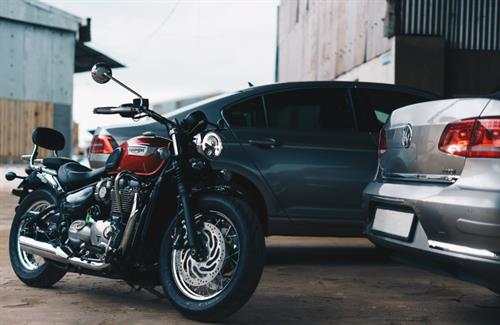Richard Gladman, IAM RoadSmart’s head of riding and driving standards, explains the POWDERY checks you should do on your car or bike before setting out on your journey.
If you have friends or family who drive or ride, please share these tips with them to help them stay safe on the road.
P – Petrol
For both drivers and riders, always make sure you fuel up before a long journey. You’ll need enough to get to your destination or the nearest petrol station.
O – Oil
Car drivers – When did you last do an oil check? Most new cars have the technology to let you know when your oil needs topping up. But for those with an older vehicle, make sure you’re checking the level regularly. Your handbook will give you the preferred method for your car.
For bike riders, you can check you have the right amount of oil by using a dipstick or sight glass in the side of the engine casing. Remember to keep the bike vertical when checking this by getting someone to sit on the bike whilst you check the oil. Bear in mind that overfilling will also cause damage, so top up slowly and check your fuel level regularly.
W – Water
Have you checked your vehicle fluid levels? For drivers, your car will alert you if you’re running low on coolant, but ideally, you shouldn’t let it get this low. Check water levels and buy coolant for your car and top it up whenever necessary. For riders, levels need to be checked if you have a water-cooled engine, ensuring the bike is vertical when you make the check. If you find that you’re low on water, remember never to use tap water – you’ll need a mix of water and antifreeze.
D – Damage
For both drivers and riders, take a look around your vehicle, checking your tyres and bodywork to ensure there is no visible damage. For riders, also remember to check your protective clothing and crash helmet to ensure they are intact. Remember it’s recommended that you replace your crash helmet every 3-5 years or if you’ve had a crash or dropped it. For car drivers, once you’re in your vehicle, make sure you have no warning lights pop up on the dashboard before you set off.
E – Electrics
Whichever vehicle you’re driving or riding, check all the lights, preferably with a helper to operate the switches or walk around whilst you do. Failing that, use the reflection of the lights in a window or a nearby car. For bike riders, remember to ensure your brake lights work from both controls. In addition to your lights, also check your horn and windscreen washers, remembering to be considerate of others when you do – waking up the neighbours or leaving puddles on the garage floor may not be popular.
R – Rubber
When did you last check your tyres? Both riders and drivers should take a look at tyre tread depth and overall condition before every journey to ensure they are road legal. Remember to check tyre pressure as well. Bear in mind this could change depending on the amount of weight your bike or car is carrying. The legal limit on a bike is 1mm across three-quarters of tyre and visible tread on the rest. The legal limit on a car is minimum 1.6mm in a continuous band around the central three-quarters of the tyre. Tyre pressures for both bikes and cars should be tested when the tyres are cold, as the reading will be higher when they’re hot.
Y – You
Are you fit to drive or ride? Have you been under the weather? Ask yourself if you’re fit to be in control of your vehicle. Medication and tiredness will affect your driving or riding, and your concentration may not be 100% if you’re ill or stressed. Check that you’re fit to drive and take a break before you set off if necessary. For bike riders, if you’ve been out of practice for a few months, then you may have lost your ‘bike fitness’. Make sure you are fit to ride your bike and remember to take it slow and steady until you’ve got to grips with it again.
Richard says: “Whether it’s a car or bike, ensuring your vehicle is in tip-top condition will help you enjoy your journey. Keep your service schedule up to date and don’t put off any replacements. Tyres should be kept in good condition, as performance will start to drop off before the legal limits of wear are reached. Don’t forget – the maintenance of your vehicle, so you have one less thing to worry about before you start a journey, is an important part of the ‘you’ in driving and riding.”

















